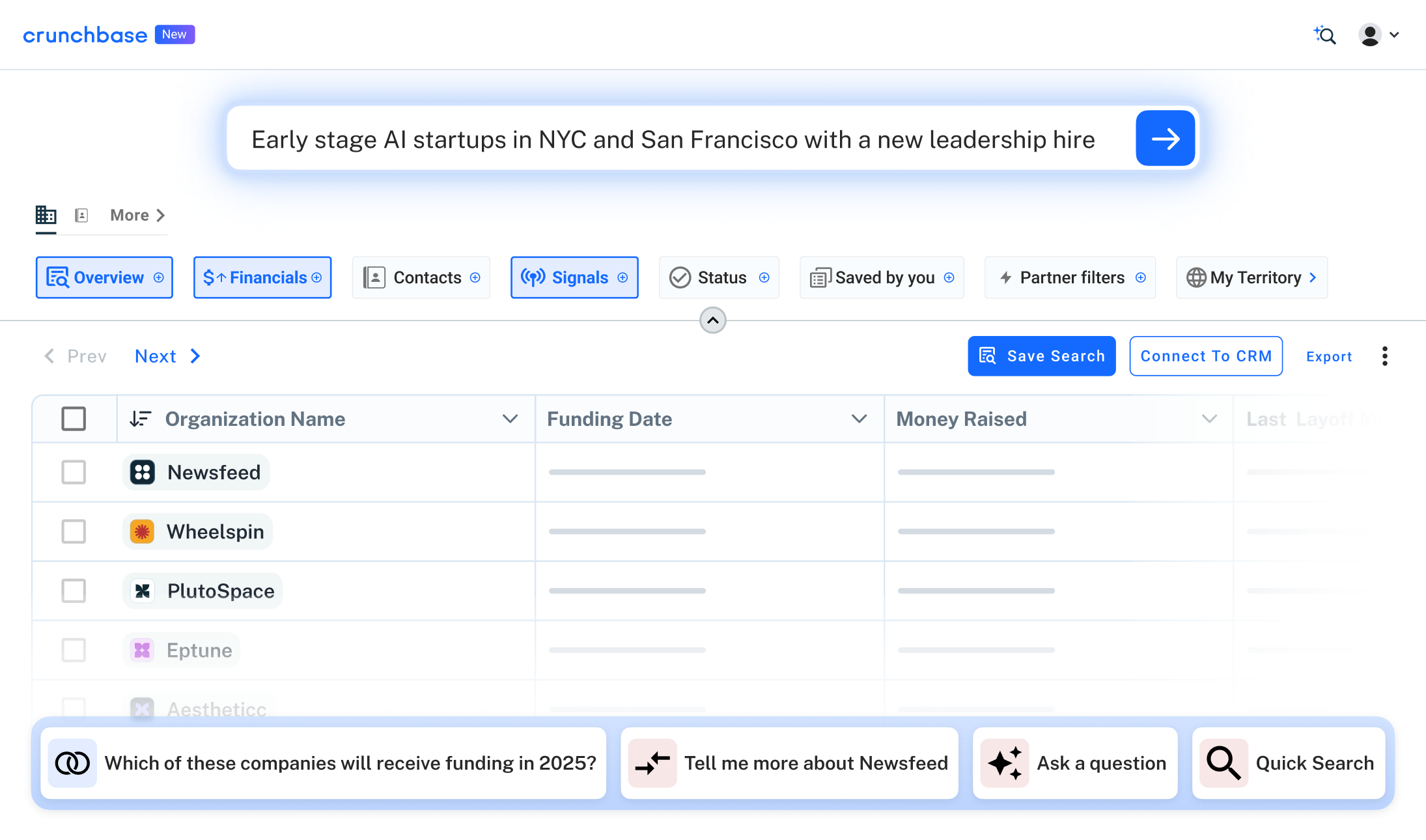Interested in downloading this data?
Funding data is available to download for Crunchbase Pro users.
Methodology
The Crunchbase Billion-Dollar Exits Board includes exits by U.S. venture-backed companies valued at $1 billion or more, starting in 2020.
Companies are included on this list based on their IPO value or M&A deal price. After exiting, a company’s value could fall below $1 billion or a company could be delisted. We still keep the company on this list based on the date and its value upon going public. Should a planned merger be canceled, the deal will be removed from this list.
We only include a company’s first exit. For example, Qualtrics was acquired in 2018 by SAP for $8 billion. Its subsequent IPO in January 2021 is not included on this list as the company had already exited.
All funding values are given in U.S. dollars unless otherwise noted. Crunchbase converts foreign currencies to U.S. dollars at the prevailing spot rate from the date funding rounds, acquisitions, IPOs and other financial events are reported. Even if those events were added to Crunchbase long after the event was announced, foreign currency transactions are converted at the historic spot price.
If we are missing any companies, please reach out to gene@crunchbase.com.
What is an exit strategy for startups?
An exit occurs when a private company is either acquired or goes public. Types of exit strategies include IPOs, SPAC deals, direct listings, buyouts, or mergers or acquisitions.
In the event of an exit, the amount invested by angel investors, venture capital investors and private equity firms becomes liquid. If successful, those investors recoup not only their initial investment, but also a significant return depending on the stage in which they invested and the amount of equity they owned.
What is the most common type of exit strategy?
The most common exit strategy for private venture-backed companies is via a merger or acquisition deal (M&A). Other exit strategies include going public and listing shares through an initial public offering (IPO) or a direct listing. SPAC mergers have also become popular exit strategies in the last few years.
What is an IPO?
An initial public offering, or IPO, is the first sale of a privately held company’s stock to the public. Once a company is public, its shares are listed on a stock exchange.
The two major public stock exchanges in the U.S. are Nasdaq and the New York Stock Exchange (NYSE). Outside the U.S., major stock exchanges include the Shanghai Stock Exchange, London Stock Exchange and Tokyo Stock Exchange.
Are there different types of IPO strategy?
There are several ways for a company’s shares to become publicly traded that are similar to an IPO, but not exactly the same. These include via:
- A direct listing, in which the company goes public without raising capital through the sale of new shares;
- A special-purpose acquisition company (SPAC), a shell company formed specifically to bring private companies to public markets.
- A reverse merger, in which a private company acquires a publicly traded shell company to become publicly traded without going through the traditional IPO process.
Read more about different types of exits further below.
What are the largest IPOs of all time?
The largest initial public offerings, or IPOs, by venture-backed U.S.-based companies are: the Facebook IPO in 2012, valued at $104 billion (the company is now called Meta); Uber, valued at $82.4 billion in its 2019 IPO; and Rivian, valued at $66.5 billion in its 2021 IPO.
What is the most valuable IPO stock?
The most valuable IPO stock honor belongs to Saudi Aramco, the Saudi Arabian oil and gas company that went public in December 2019. The company raised about $25.6 billion, making it the largest IPO in history.
Which companies had their IPO in recent years?
Dozens of companies had IPOs and other public market debuts in the past several years. The largest public market debut in recent years was cryptocurrency exchange Coinbase. Coinbase’s 2021 debut was not an IPO, but a direct listing that valued it at $86 billion.
The largest U.S.-based IPOs since 2020 include Rivian (mentioned above); rental accommodation company Airbnb, valued at $47 billion in its 2020 IPO; delivery company DoorDash, valued at $39 billion in its 2020 IPO; robotic process automation company UiPath, previously headquartered in the U.K. and valued at $35 billion in its 2021 IPO; Snowflake, valued at $33.3 billion in its 2020 IPO; and stock brokerage company Robinhood, valued at $32 billion in its 2021 IPO.
Other notable companies that had IPOs were Beijing-based video platform Kuaishou Technology, South Korea-based e-commerce company Coupang, and Beijing-based ride-sharing platform Didi. All of these companies had IPOs in 2021.
Many other unicorn companies, including Lucid Motors, Grab, SoFi and Aurora, went public in 2021 via SPAC mergers. (See all the tech companies that went public in 2021, a record year for IPOs.)
The biggest company that had its IPO in 2020 is Airbnb, which raised $3.5 billion in its offering. Other notable companies that had their IPO in 2020 include DoorDash, Snowflake, Palantir and Unity. (See all the tech companies that went public in 2020.)
The largest venture-backed company that had an IPO in 2019 is Uber, with its $82.4 billion valuation. Other tech companies that had IPOs in 2019 include Lyft, Cloudflare, Zoom, Slack and Beyond Meat. (See all the venture-backed companies that went public in 2019.)
Why do companies go public?
Companies go public for many reasons. One of the main benefits of IPO exits include providing access to capital and liquidity for existing shareholders such as founders, employees and early investors.
Publicly traded companies are also able to use their shares as capital for making acquisitions.
A public listing also generally instills more confidence in the company and its stakeholders, because joining the public markets requires a dependable market-determined valuation and the company has met certain regulatory requirements and undergone scrutiny by financial authorities.
Which companies have upcoming IPOs?
What are IPO benefits for employees?
Public companies may offer stock options, restricted stock units or other equity-based compensation programs to attract and retain talented employees.
Granting these incentives is a valuable tool for recruiting top talent and aligning employees’ interests with those of the company and its shareholders.
What are valuation multiples and how are they used to determine an initial price range for IPO shares?
IPO valuation multiples are financial ratios used to estimate the value of a company when it goes public. These ratios help investors and analysts compare the company’s financial performance to similar companies in the market.
Valuation multiples play an important role in IPO pricing by providing a framework for investors and underwriters to assess the value of a company and determine a suitable IPO share price range.
During the IPO process, investment banks and underwriters analyze the company’s financials, growth prospects, industry comparables and market conditions. Valuation multiples such as the price-to-earnings (P/E) ratio, price-to-sales (P/S) ratio and other relevant criteria are considered to gauge how the company’s valuation compares to its peers and overall industry.
Valuation multiples help investors understand how the company is priced in relation to its financial performance, but are just one part of the overall evaluation process. Other factors such as market conditions, investor demand and growth prospects also impact the IPO price.
Read more about how IPOs are priced.
What does an IPO valuation calculation entail?
Some of the common elements to calculate valuation of a company include an analysis of the company’s financial statements and comparable companies. In addition to an estimate of the present value of the company’s expected future cash flows, it takes into account the prevailing market conditions and investor sentiment as well as input from the investment banks or underwriters managing the IPO process.
While these methods and considerations are typically used in combination to arrive at an IPO valuation range, the final valuation decision is often made by the company and its underwriters.
What are the most common private equity exit strategies?
Some of the most common exit strategies for private equity firms include IPOs, a sale to a strategic buyer (M&A) or to another private equity firm (secondary buyout), recapitalization (issuing new debt or equity), a management buyout, a dividend recapitalization (taking a significant dividend payment), or liquidation.
What is the difference between a merger and an acquisition?
A merger and an acquisition both result in the combination of two companies into a single entity, but there are some key differences. A merger is typically a combination of two equal partners, while an acquisition is the takeover of one company by another.
With a merger, the resulting company typically has a new name and a new corporate identity.
An acquisition occurs when one company buys another company and assumes control of its operations. In that case, the acquired company often becomes a subsidiary of the acquiring company and the acquiring company gains control over the subsidiary’s operations, management and assets. The acquired company often retains its original name and brand.
What are the largest tech, software and startup acquisitions of all time?
The largest acquisition of a U.S.-based private company was messaging app WhatsApp, acquired by Meta (then called Facebook) in 2014 for $19 billion.
How does a SPAC merger work?
A SPAC deal is a transaction in which a special-purpose acquisition company (SPAC) combines with a privately held company in order to give the private company status as a public company on an exchange such as Nasdaq or NYSE. The process typically begins with a SPAC raising capital via a public offering of its own shares. The proceeds from that offering are then used to acquire a private company, often a venture-backed startup. A SPAC merger is sometimes called a blank-check merger.
A SPAC merger’s main advantage compared to a traditional IPO is that it enables a company to go public faster and at lower cost. However, SPACs are generally considered to be riskier for investors than an IPO, and regulatory requirements can be more complex.
SPAC mergers became popular in 2020 and 2021, with companies including WeWork, 23andMe, Faraday Future, Clover Health, Metromile and BuzzFeed taking that route to the public markets. SPAC deals were especially popular as a way to take capital-intensive businesses such as electric-vehicle startups public faster, and with fewer constraints, than via the traditional IPO process. However, many companies that went public via SPAC in recent years have seen their stock performance struggle on the public markets.
Read all of our SPAC coverage.
What are the biggest SPAC mergers of all time?
The largest SPAC merger to list was Singapore-based transportation company Grab in 2021, valued at $40 billion. In the U.S., electric-vehicle company Lucid Motors listed in 2021 at a value of $24 billion.
What is a direct listing?
A direct listing is another way for a private company to go public. A direct listing enables a company to make its shares directly available to the investing public without the underwriting process or restriction of IPO pricing that comes with a traditional IPO.
Typically faster, easier and less expensive than an IPO, a direct listing doesn’t require an underwriting process or fees and faces fewer regulatory requirements. A direct listing also offers companies more flexibility in how much stock they list, who can participate and the pricing.
A direct listing does have disadvantages compared to an IPO,however. Because it doesn’t involve underwriters, a direct listing has no minimum guaranteed price for the shares and doesn’t enjoy the “stamp of approval” the underwriting process brings. There may also be liquidity concerns, since a direct listing doesn’t involve the issuance of new shares. A direct listing may also suffer from lack of investor awareness, since it doesn’t have large underwriting firms promoting the offering and drumming up investor interest.
What are the biggest direct listings of all time?
The largest direct listings are cryptocurrency exchange Coinbase, valued at $86 billion in its 2021 direct listing; gaming company Roblox, which went public in 2021 at a value of $30 billion, and music sharing company Spotify, which listed in 2018 at a value of $29.5 billion.
Where can I find all of Crunchbase’s coverage of exits, IPOs, M&A and SPACs?
I’m a journalist/researcher/student. Can I cite The Crunchbase Billion-Dollar Exit Board in my work?
Yes. Our vision is for The Crunchbase Billion-Dollar Exit Board to be a public resource. We ask that you please cite Crunchbase as the data source and include a link for this list when possible.
For additional press inquiries, email press@crunchbase.com.


![Illustration of agentive AI brain - Europe - Quarterly. [Dom Guzman]](https://news.crunchbase.com/wp-content/uploads/Agentive_AI_europe-414x232.jpg)

![Illustration of agentive AI brain - North America - Quarterly. [Dom Guzman]](https://news.crunchbase.com/wp-content/uploads/Agentive_AI_n-america-414x232.jpg)
![Illustration of agentive AI brain - Global - Quarterly. [Dom Guzman]](https://news.crunchbase.com/wp-content/uploads/Agentive_AI_global-414x232.jpg)

![M&A - Illustration of a magnet attracting various products. [Dom Guzman]](https://news.crunchbase.com/wp-content/uploads/mergers_and_acquisitions-414x232.jpg)



![Illustration of a suitcase stuffed with money. Megafunds [Dom Guzman]](https://news.crunchbase.com/wp-content/uploads/Megafunds-414x232.jpg)

